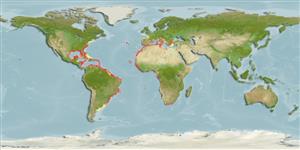>
Eupercaria/misc (Various families in series Eupercaria) >
Labridae (Wrasses) > Xyrichtyinae
Etymology: Xyrichtys: Greek, xyreo = that cuts like a knife + Greek, ichthys = fish (Ref. 45335); novacula: Specific name from Latin 'novacula' meaning 'razor'; referring to it being very compressed with front of head forming a sharp edge..
More on author: Linnaeus.
Environment: milieu / climate zone / depth range / distribution range
Ecología
marino asociado a arrecife; rango de profundidad 1 - 90 m (Ref. 3726). Subtropical
Western Atlantic: North Carolina, USA and northern Gulf of Mexico (Ref. 7251) through the Caribbean to Brazil. Eastern Atlantic: France to Angola and including the Mediterranean, Azores, Madeira, Canary Islands, Cape Verde and Sao Tome Island.
Tamaño / Peso / Age
Maturity: Lm ? range ? - ? cm
Max length : 38.0 cm TL macho / no sexado; (Ref. 7251); common length : 20.0 cm TL macho / no sexado; (Ref. 2683); edad máxima reportada: 8 años (Ref. 4742)
Espinas dorsales (total): 9; Radios blandos dorsales (total): 12; Espinas anales 3; Radios blandos anales: 12. An elongate, very compressed fish with front of head forming a sharp edge. Snout very blunt; profile steep. Pale greenish, usually with no conspicuous markings on body (Ref. 26938). Head with alternating vertical lines of light blue and light yellow-orange (Ref. 13442).
Inhabits clear shallow areas with sandy bottoms, usually in the vicinity of seagrass beds and corals (Ref. 2683). Feeds mainly on mollusks; also crabs and shrimps (Ref. 3726). A protogynous hermaphrodite; sexual dimorphism apparent in head shape and length of pelvic fin (Ref. 5292). Builds nests with coral debris. Dives head first into the sand when frightened (Ref. 9710). Marketed fresh (Ref. 3726).
Life cycle and mating behavior
Madurez | Reproducción | Puesta | Huevos | Fecundidad | Larva
Gomon, M.F. and P. Forsyth, 1990. Labridae. p. 868-882. In J.C. Quero, J.C. Hureau, C. Karrer, A. Post and L. Saldanha (eds.) Check-list of the fishes of the eastern tropical Atlantic (CLOFETA). JNICT, Lisbon, SEI, Paris; and UNESCO, Paris. Vol. 2. (Ref. 5292)
IUCN Red List Status (Ref. 130435)
Threat to humans
Harmless
Human uses
Pesquerías: escaso valor comercial; pesca deportiva: si; Acuario: Comercial
Más información
ReferenciasAcuiculturaPerfil de acuiculturaRazasGenéticaElectrophoresesheritabilidadEnfermedadesProcesamientoNutrientsMass conversion
Herramientas
Special reports
Download XML
Fuentes de Internet
Estimates based on models
Preferred temperature (Ref.
123201): 17.4 - 27.9, mean 24.4 °C (based on 858 cells).
Phylogenetic diversity index (Ref.
82804): PD
50 = 0.5005 [Uniqueness, from 0.5 = low to 2.0 = high].
Bayesian length-weight: a=0.00955 (0.00680 - 0.01341), b=3.00 (2.90 - 3.10), in cm total length, based on LWR estimates for this species (Ref.
93245).
Nivel trófico (Ref.
69278): 3.5 ±0.1 se; based on diet studies.
Generation time: 4.2 ( na - na) years. Estimated as median ln(3)/K based on 2
growth studies.
Resiliencia (Ref.
120179): Medio, población duplicada en un tiempo mínimo de 1.4-4.4 años (tmax=8).
Fishing Vulnerability (Ref.
59153): Moderate vulnerability (36 of 100).
Nutrients (Ref.
124155): Calcium = 32.8 [14.9, 67.1] mg/100g; Iron = 0.522 [0.286, 1.082] mg/100g; Protein = 18.8 [15.9, 21.0] %; Omega3 = 0.142 [0.077, 0.259] g/100g; Selenium = 18.7 [8.5, 39.1] μg/100g; VitaminA = 56.4 [15.9, 255.3] μg/100g; Zinc = 0.892 [0.550, 1.509] mg/100g (wet weight);
